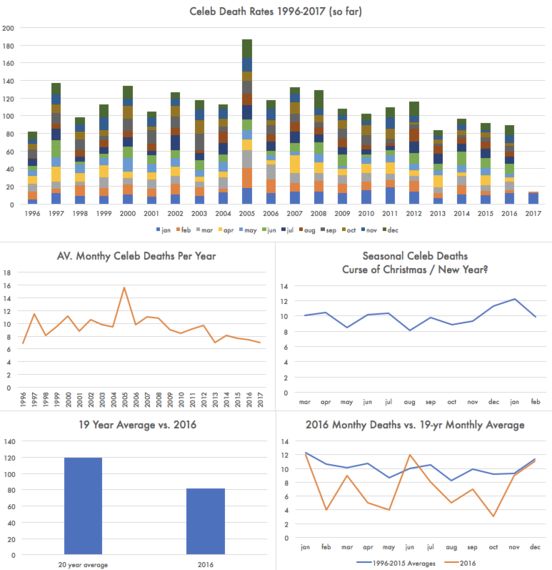You might find it hard to accept, but contrary to all the news stories (and Facebook posts) that declared 2016 as an unusually bad year for celebrity deaths, it wasn't. In fact 2016 was probably below average for famous departures. The idea that 2016 was an unusually high celeb death year is an example of the way news media, your social network and cognitive bias affects our view of the world. It's a sobering thought.

(image credit: Andrew Keith Walker)
Sceptical? Good.
When data shows something we find hard to accept (like 2016 was one of the lowest years for celeb deaths in the last 20) we automatically assume the data is wrong. But here's the interesting part, the data doesn't have to be comprehensive provided you've got enough of it. Trends within a decent sample size are usually indicative of the whole, here's an example:
If you analyse the distribution of matter in our solar system (stars, planets, asteroids etc.) you'll get a distribution that is strikingly similar to the rest of the cosmos. Stuff forms big clumps with huge gaps sparsely filled with smaller specks of stuff. If you study a few hundred more solar systems, you'll add more data, which might vary considerably but that clump-gap trend remains constant. It's called a 'Zipf distribution' and it's a data pattern common to many things, like baby names, popular cars, job titles, income brackets, and so on.
Is the data reliable?
No list of celeb deaths can ever be complete because fame is a matter of perspective. For example, was Country Music Hall of Fame legend Merle Haggard less famous than Prince, who died the same month in 2016? That depends on your age and musical tastes. Haggard's career in the spotlight was over twice as long and he had a greater concentration of fans in certain demographic segments. Fame is hard to measure objectively.
But if you analyse a dataset of celeb deaths (1996-2017), with a decent sample size (approx. 2500 deaths) and consistent selection criteria, at that scale, it's a reliable indicator of the death rate trend. It doesn't matter if you add a few hundred deaths spread across the timeframe, the sample has enough statistical resilience to accommodate the new data without changing the overall trend.
In fact, you could double the number of data points and the probabilities of that being heavily weighted enough to change the overall trends are relatively slim... it would be hard to miss 2500 deaths in just a few years. The additional data is more likely to be distributed across the whole data range, and at the end of it, show a similar big picture trend.
I reviewed a few sets before choosing Laurie Mann's Dead People Server as my source, with a consistent selection criteria (one curator) and a mix of 2405 artists, writers, musicians, actors, directors, producers, politicians and royalty.
So what is the trend?
The death rate for celebs is slowing, slightly. Which is hardly surprising. Old people are living longer these days. Medicine has advanced. Lifestyles are healthier. Affluent people (celebs) also tend to have longer life expectancy. Combine those global demographic factors and it's hardly surprising 2016 was one of the lowest years for celeb deaths over the last 20.
Very predictably, the Dead People Server figures suggest overall more old celebs died between 1996-2006 than the following decade. Between 1996-2015, celebs died at an average rate of 10.41 per month. In 2016 it was 7.42 per month, the lowest year for celeb deaths since 1997 (1996 was 6.83 deaths per month). Even if the Dead People Server sample was missing 20% of 2016 celeb deaths it would still make it a pretty average year.
You also need to consider that natural rhythms in technology and marketing cycles tend to recruit new cohorts of celebs at a similar age, and they die off in waves, e.g. 1950s Hollywood celebs, 1960s TV celebs, 1970s mass market crime authors and 1980s CD music artists.
Eventually, all people of a certain age tend to die of old age and age-related health issues. As will 1990s MTV marketing boomers, the 00s Indie Youtube generation, and the reality-TV-music-onimchannel Kardashian combos... probably at roughly similar times per cohort, with overlaps creating peaks and troughs in the totals, with the overall rate slowing as life expectancy increases over time.
Why is this important?
Trump, Brexit, Russians, hackers, propaganda, celeb deaths, these media narratives made 2016 appear cursed. Without a measure of objectivity to check the influence of buzz and hype, the world can seem a much scarier place than it really is. In an age of fake news, alternative facts and increasing tribalism within political and social movements across the world, it's important to remember how easily reason can be overwhelmed by superstition.
